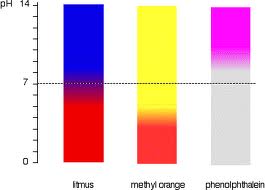Difference between revisions of "Indicators"
(Created page with "Category:Indicators{{Knoppen}} <noinclude><!------------------------------------------------ * READ THIS FIRST * Only edit this page if you can improve the content. * Im...") |
|||
| Line 1: | Line 1: | ||
[[Category:Indicators]]{{Knoppen}} | [[Category:Indicators]]{{Knoppen}} | ||
[[File:Indicators.jpg|thumb|right|Indicators]] | |||
'''Indicator''' is a halochromic chemical compound that is added in small amounts to a solution so that the pH (acidity or basicity) of the solution can be determined visually. Hence a pH indicator is a chemical detector for hydronium ions (H3O+) or hydrogen ions (H+) in the Arrhenius model. Normally, the indicator causes the colour of the solution to change depending on the pH. Indicators can also show change in other physical properties; for example, olfactory indicators show change in their odor. | |||
At 25 °C, considered the standard temperature, the pH value of a neutral solution is 7.0. Solutions with a pH value below 7.0 are considered acidic, whereas solutions with pH value above 7.0 are basic (alkaline). As most naturally occurring organic compounds are weak protolytes, carboxylic acid and amines, pH indicators find many applications in biology and analytical chemistry. Moreover, pH indicators form one of the three main types of indicator compounds used in chemical analysis. For the quantitative analysis of metal cations, the use of complexometric indicators is preferred, whereas the third compound class, the redox indicators, are used in titrations involving a redox reaction as the basis of the analysis. | |||
==Application== | |||
Indicators are frequently employed in titrations in analytical chemistry and biology to determine the extent of a chemical reaction. Because of the subjective choice (determination) of color, indicators are susceptible to imprecise readings. For applications requiring precise measurement of pH, a pH meter is frequently used. Sometimes a blend of different indicators is used to achieve several smooth color changes over a wide range of pH values. These commercial indicators are used when only rough knowledge of pH is necessary. | |||
Latest revision as of 23:07, 25 January 2013
Indicator is a halochromic chemical compound that is added in small amounts to a solution so that the pH (acidity or basicity) of the solution can be determined visually. Hence a pH indicator is a chemical detector for hydronium ions (H3O+) or hydrogen ions (H+) in the Arrhenius model. Normally, the indicator causes the colour of the solution to change depending on the pH. Indicators can also show change in other physical properties; for example, olfactory indicators show change in their odor.
At 25 °C, considered the standard temperature, the pH value of a neutral solution is 7.0. Solutions with a pH value below 7.0 are considered acidic, whereas solutions with pH value above 7.0 are basic (alkaline). As most naturally occurring organic compounds are weak protolytes, carboxylic acid and amines, pH indicators find many applications in biology and analytical chemistry. Moreover, pH indicators form one of the three main types of indicator compounds used in chemical analysis. For the quantitative analysis of metal cations, the use of complexometric indicators is preferred, whereas the third compound class, the redox indicators, are used in titrations involving a redox reaction as the basis of the analysis.
Application
Indicators are frequently employed in titrations in analytical chemistry and biology to determine the extent of a chemical reaction. Because of the subjective choice (determination) of color, indicators are susceptible to imprecise readings. For applications requiring precise measurement of pH, a pH meter is frequently used. Sometimes a blend of different indicators is used to achieve several smooth color changes over a wide range of pH values. These commercial indicators are used when only rough knowledge of pH is necessary.
